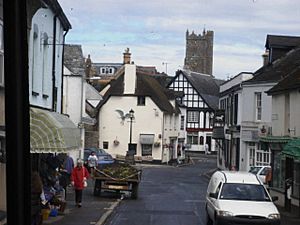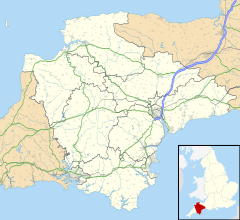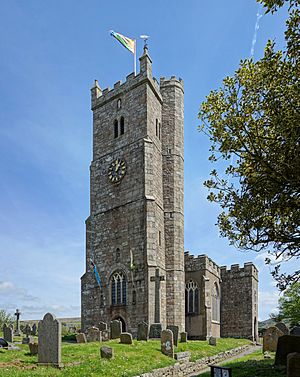Moretonhampstead facts for kids
Quick facts for kids Moretonhampstead |
|
|---|---|
 Town centre |
|
| Population | 1,703 |
| OS grid reference | SX752860 |
| • London | 215 miles (346 km) |
| Civil parish |
|
| District |
|
| Shire county | |
| Region | |
| Country | England |
| Sovereign state | United Kingdom |
| Post town | NEWTON ABBOT |
| Postcode district | TQ13 |
| Dialling code | 01647 |
| Police | Devon and Cornwall |
| Fire | Devon and Somerset |
| Ambulance | South Western |
| EU Parliament | South West England |
| UK Parliament |
|
| Website | http://www.moretonhampstead.com/ |
Moretonhampstead is a historic market town located in Devon, England. It sits right on the edge of Dartmoor National Park, a beautiful area of open moorland. The town's parish also includes a small village called Doccombe.
In 2011, about 1,703 people lived in Moretonhampstead. The town is home to St. Andrew's Church, a very old building. Moretonhampstead has one of the longest place names in England, with 16 letters! It is also twinned with a town in France called Betton.
Contents
What's in a Name? The Story of Moretonhampstead
The name Moretonhampstead has a long history. In 1086, it was simply called MORTONE. This part of the name comes from an old English word meaning a town or village on moorland. This makes sense, as the town is located near Dartmoor.
Later, in 1493, the name "Morton Hampstead" was used. The "Hampstead" part is a bit of a mystery. Some people think it might be a family name, but no one is completely sure why it was added.
For a long time, many local people just called the town "Moreton." However, when the railway arrived, the station was named Moretonhampstead. This was to make sure it wasn't confused with the many other towns called Moreton or Morton across the country.
A Glimpse into Moretonhampstead's Past
The area around Moretonhampstead was settled by the Saxons after the year 710. Over time, the land was divided into different estates. Moreton became the main settlement in one of these areas, located between the Teign and Bovey rivers.
Moretonhampstead was a royal estate after the Norman Conquest in 1066. This means it belonged to the King. Later, a nobleman named Richard de Burgh held the land from the King. He paid a very unusual rent: one sparrow hawk each year!
The town then became the home of the Courtenay family, a powerful noble family. They owned the manor for many years.
For over 700 years, the main industry in Moretonhampstead was wool and making woollen cloth. The town even had a water-powered mill for processing wool before the 13th century.
In 1207, King John allowed Moretonhampstead to hold a weekly market and a yearly five-day fair. This shows that the town was becoming an important local center for trade. Moretonhampstead grew steadily and was very successful until the wool industry started to decline in the late 1600s. Even after that, it remained a key trading spot and a place for travelers to rest.
Sadly, several fires in the 20th century destroyed many old buildings. However, enough historic buildings remain to show the town's ancient past and its success in the wool trade. Much of the town is now a special conservation area, which helps protect its historic buildings. The entire parish is also part of Dartmoor National Park.
The Sparrowhawk Symbol
Because King John set the town's rent as one sparrowhawk per year, this bird has become a special symbol for Moretonhampstead. It is even being included in new public artworks around the town.
Famous People from Moretonhampstead
- George Parker Bidder (1806–1878): He was known as "the calculating boy" because he was incredibly good at mental math. He later became a famous engineer. The house where he was born sadly burned down in 1926.
Interesting Places to Visit
The Cross Tree
The Cross Tree is a famous spot in Moretonhampstead. It was even mentioned in a novel called Christowell by R. D. Blackmore. The original tree, a large elm shaped like a punch bowl, is no longer there. Now, a beech tree stands in its place, and a piece of the old cross is nearby. In the past, people would dance around the original tree. It's said that French officers, who were prisoners during the Napoleonic Wars, would gather there with their band.
The Almshouses
Behind the Cross Tree, you'll find the historic almshouses, built from strong granite. The date 1637 on the outside shows when they were updated, but the main parts of these buildings are actually much older, possibly two hundred years older! These buildings were once homes for people in need. They have been repaired and changed over the years. In 1952, the National Trust bought them to help protect them.
St Andrew's Church
St. Andrew's Church is a very important historic building, given a special Grade I listing. It's located at the eastern end of the town. The church's tall, four-story tower was being built as early as 1418. The whole church is made from granite blocks.
Inside, the church has two side sections, called aisles, separated from the main area (the nave) by arches. All the windows are in a style called Perpendicular, which was popular in England long ago. The church has been repaired and updated many times, especially in the 1800s. You can still see a wall memorial to Rev Francis Whiddon, who was a minister there for 32 years.
Tourism in Moretonhampstead
Moretonhampstead is a popular place for tourism. Its location makes it a great base for exploring both Dartmoor and the wider area of Devon. The town center is about 700 feet (213 meters) above sea level. If you take a short walk, you can reach over 1,100 feet (340 meters) and enjoy amazing views.
The town has several pubs and cafes, along with many places to stay, including hotels, bed and breakfasts, and camping sites. Moretonhampstead also has good sports facilities. Because it's so close to Dartmoor, it's a favorite spot for walkers and cyclists, especially those who enjoy mountain biking.
Moretonhampstead's Weather
| Climate data for Moretonhampstead, 1981–2010 normals | |||||||||||||
|---|---|---|---|---|---|---|---|---|---|---|---|---|---|
| Month | Jan | Feb | Mar | Apr | May | Jun | Jul | Aug | Sep | Oct | Nov | Dec | Year |
| Mean daily maximum °C (°F) | 8 (46) |
8 (46) |
10 (50) |
12 (54) |
15 (59) |
18 (64) |
20 (68) |
20 (68) |
18 (64) |
14 (57) |
10 (50) |
8 (46) |
13.4 (56.1) |
| Mean daily minimum °C (°F) | 1 (34) |
2 (36) |
2 (36) |
3 (37) |
6 (43) |
9 (48) |
11 (52) |
11 (52) |
9 (48) |
7 (45) |
4 (39) |
2 (36) |
5.6 (42.1) |
| Average precipitation mm (inches) | 147.9 (5.82) |
112.6 (4.43) |
109.3 (4.30) |
88.6 (3.49) |
92.9 (3.66) |
75.4 (2.97) |
80.8 (3.18) |
85.4 (3.36) |
97.6 (3.84) |
147.8 (5.82) |
143.0 (5.63) |
163.5 (6.44) |
1,344.8 (52.94) |
| Source: Chelsa Climate | |||||||||||||
Fun Events in Town
Moretonhampstead hosts an annual carnival in the fourth week of August. This event helps raise money for local groups. Since 2012, the town has also held a yearly flag festival. Other fun events include a fireworks night, a yearly pantomime (a type of musical play), a food and drink festival, and various music events throughout the year.
Getting Around Moretonhampstead
The town is located on the A382 road, which connects it to larger roads like the A38 and A30.
Moretonhampstead used to have a train station. It opened in 1866 but stopped carrying passengers in 1959. Goods trains continued until 1964. After that, the old train sheds were used by a road transport business for many years.
Today, you can catch buses from the car park just west of the town center. These buses can take you to places like Exeter, Okehampton, and Newton Abbot.
Sports and Fun Activities
Moretonhampstead has a great place for sports and recreation called King George's Field. This facility was created as a memorial to King George V. It has indoor courts for sports like basketball, a gym, and rooms you can rent for meetings. Outside, there are fields for cricket and football, a camping site, and a skate park.
See also
 In Spanish: Moretonhampstead para niños
In Spanish: Moretonhampstead para niños



